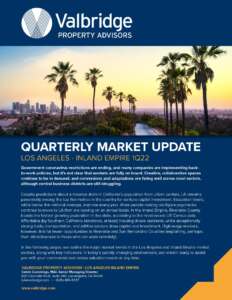Q1 2022 Market Trends Newsletter
May 5, 2022
Government coronavirus restrictions are ending, and many companies are implementing back- to-work policies, but it’s not clear that workers are fully on board. Creative, collaborative spaces continue to be in demand, and conversions and adaptations are faring well across most sectors, although central business districts are still struggling.
Despite predictions about a massive drain in California’s population from urban centers, LA remains perennially among the top five metros in the country for venture capital investment. Education levels, while below the national average, improve every year. More people making six-figure paychecks continue to move to LA than are leaving on an annual basis. In the Inland Empire, Riverside County boasts the fastest growing population in the state, according to the most recent US Census data. Affordable (by Southern California standards, at least) housing draws residents, while exceptionally strong trade, transportation, and utilities sectors draw capital and investment. High-wage workers, however, find far fewer opportunities in Riverside and San Bernardino Counties (explaining, perhaps, their attractiveness to those who can work remotely).
Meanwhile, multifamily spaces present mostly positive outlooks for the upcoming year as rental markets remain tight and residential property values stay much higher than traditional market averages. The multifamily sector is trying to recapture pre-pandemic rates and is on track to do so, although likely not this coming quarter. In the past quarter, unemployment in LA leveled off at around 10%, and stabilized at around 8% in the Inland Empire.

Below, we outline the major market trends in four critical Los Angeles and Inland Empire major market sectors, along with key indicators, download the PDF. In today’s quickly changing environment, we remain ready to assist you with your commercial real estate valuation needs at any time.
LOS ANGELES INDUSTRIAL REAL ESTATE TRENDS
-
While local Los Angeles ports handle 78% of West Coast container volume and nearly a third of all imports to the U.S., a potential
work stoppage at the ports looms for this summer as dockworkers renegotiate their contracts. -
Although 41.6 million SF have been delivered over the past decade, inventory levels have remained fairly consistent due to the demolition of 35.3 million SF some properties were redeveloped into more modern industrial facilities while others were converted into creative office spaces.
- Vacancies are highest in the Central LA Submarket (including DTLA and surroundings). LA consistently has the lowest vacancy rate among major U.S. industrial markets.
- Rents are highest in submarkets where industrial users compete with other property types. Tenants on expiring leases can expect to pay rates all 50% or more above their previous deals.
INLAND EMPIRE INDUSTRIAL REAL ESTATE TRENDS
- Demand remains high, with net absorption totaling 31.7 million SF over the past year and rents increasing by 13.1% over the same period. The near-term forecast predicts that demand will continue to outpace supply, with vacancies remaining lower than 2%.
- Rents in the IE have continued to rise: a year-over-year comparison shows an annual gain of 13.1% (vs 10.2% in the year prior.
- 38.4 million SF of space is currently under construction (which represents about 5.5% of existing inventory), with more than half of that new construction concentrated in the Ontario Airport area, Riverside, and the Moreno Valley/Perris.
- Institutional, public REIT, and private equity investors have significantly increased interest in the market and have held assets as valuations rose: over the past five years, more than half of buyers (but only 25% of sellers) have been institutional players.
LOS ANGELES OFFICE REAL ESTATE TRENDS
- The outlook continues to be grim for the LA office sector. Vacancies are at a 25-year high of 19.3%, the highest level since the onset of the pandemic, while rental rates are down from a peak in 2020Q1. This is good news for tenants, who are seeing concessions and other generous incentives.
- The supply of sublease space remains at record levels: 9.7 million SF are currently available (about 4.5 million SF higher than pre-pandemic averages).
- Despite these poor conditions, landlords have been holding firm on asking rates since the second half of 2020.
- Average marketing pricing is expected to rise slightly over the next five years, but structural changes in the nature of work (remote, in-office, hybrid) make those predictions tentative indeed.
INLAND EMPIRE OFFICE REAL ESTATE TRENDS
- The Inland Empire’s office vacancy rate has held steady at an average of 6.9%. After a drop in 2020, sales activity has picked up, but volume is still lower than pre-pandemic levels.
- The current vacancy rate is 6.4%, compared to 9.6% a year ago, due in large part of a high concentration of medical office space.
- The IE has seen some of the strongest office rents gain of any major office market in the U.S. The overall market rent in Inland Empire is $24.00/SF, up 2.8% over the past year (although the western areas of the UE have seen higher asking rates than the eastern areas).
- Despite recent strong performance in rent growth, construction has stalled, likely because of higher costs and the uncertain future of the office sector (especially when compared to the IE behemoth that is industrial construction). Only a few projects are underway, totaling 410,000 SF.
LOS ANGELES RETAIL REAL ESTATE TRENDS
- Some retail vacancies – especially big box sites with good freeway access – have been acquired for redevelopment into industrial sites. Developers are focusing on properties with proximity to regional light rail.
- Fitness centers and grocers have been strong performers, adding locations while many other retail subsectors have struggled.
- Retail rents, although higher than the national average, remain low for LA, and are now holding around $34/SF. There is a wide spread in asking rates, while only a very few submarkets (e.g. Beverly Hills) showing positive annual growth. Metro rental rates are expected to decline for at least the near term.
- Average market cap rates are currently 5.3%, well below the national average of 6.9%.
INLAND EMPIRE RETAIL REAL ESTATE TRENDS
- Annual rent gains in the IE are strong at 6.6%, compared to the five-year average of 3.8% per year.
- Leasing volume has returned to pre-pandemic levels, particularly in suburban areas, with small and mid-sized spaces the most popular.
- Vacancies are expected to decline over the next four quarters, fueled by rising job growth in the area and the resultant local buying power. Likewise, rents are expected to rise over the next year.
- Over the past 12 months, sales volume was highest in the Coachella Valley, San Bernardino, and South Riverside submarkets.
- The IE retail market cap rate is at 5.9%, and is expected to hold steady over the next year.
LOS ANGELES MULTIFAMILY REAL ESTATE TRENDS
- Vacancies in the LA apartment market have been trending down since a peak at the end of 2020, and are currently 3.4%, with strong demand in recent quarters.
- 28,000 market-rate units are under construction: this is almost the highest level seen in the past two decades. Despite this fact, the market remains chronically undersupplied (especially when it comes to affordable housing).
- Average asking rents in LA have risen by 7.6% during the past 12 months, which is about four points below the national average; they currently stand at an average of $2,130/month. More affordable locations (including the Antelope Valley and parts of the San Fernando Valley and San Gabriel Valley) have ouperformed higher-end locations in terms of rent growth.
- Average market cap rates, at 4.0%, are below the national average of 5.2%.
INLAND EMPIRE MULTIFAMILY HOUSING REAL ESTATE TRENDS
- The vacancy rate has fallen to 2.6%, well below the five-year average of 3.8%. Some renters have moved to buy homes, but ownership remains far out of reach for most renters in the region; demand is likely to remain strong.
- Rents in the Inland Empire have risen by 13.3% over the past 12 months, easily outpacing the 10-year average increase of 5.8% per year.
- The average market cap rate is 4.4%, compared with the five-year average of 4.9%.
- Trade, transportation, and utilities sectors in the IE have exceeded pre-pandemic highs, thanks to strong job growth at logistics firms and e-commerce players (including Amazon), so more population influx seems likely, continuing to drive strong demand for housing.
For more, including a deep dive into supply chain challenges, DOWNLOAD FULL REPORT HERE.


